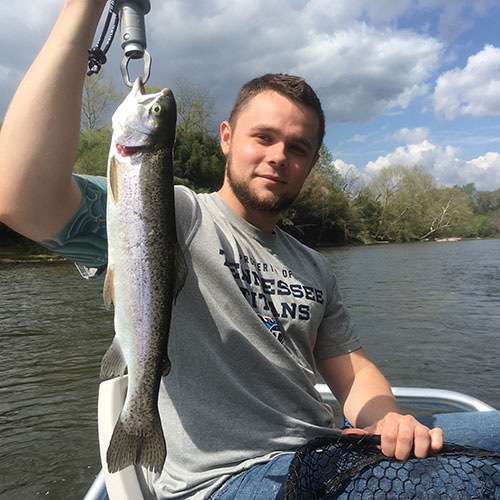When you think of hog hunting, you think of chasing a pack of screaming hounds, trying to get a hold of an animal that can cut their guts out in a minute if the dog gets too close. The type of hog hunting anglers in Swain and Jackson Counties will be focused on the next few months, will be monster browns and rainbows that call the delayed harvest sections of the Tuck their home.
Jackson County was the first to take advantage of the delayed harvest program, which is simply catch and release from October 1st thru June 1st. Then, it goes back to hatchery-supported rules. During the delayed harvest period, an angler can fish with any single hook lure as long as it has no scent or taste. This rule is for the fish’s survival after it is released. A scented lure will usually be swallowed deeper and the trout can’t be released without damaging it, the same goes for the single hook rule. Although most fish caught will be in the 10 to 13 inch range, the state stocks some real “hogs”. The trophy many anglers go after are what we call “holdovers,” which are trout stocked previous years which have survived the hatchery opener. Most of these fish will be in the high 20 inch range. They have adapted to the river environment, so they feed on natural food such as stoneflies, crayfish and minnows.
The Tuck has an abundance of sucker fish and the browns really key on these. For that reason, I love to fish a diving crankbait. Just be sure to remove the treble hooks before you go. These fish have adapted to heavy currents so you can look for the fight of your life. The rooster tail spinner is also a good bet on the Tuck. A lot of soft plastics will catch fish here, just be sure they are unscented.
The fly fishing “purest” is not left out of this picture at all. We catch fish all winter on flies. I like the traditional patterns, like the Prince, Hare’s Ear, and the Copper John, but lately it seems the y2k and the rainbow warrior work a little better. Don’t forget to have a lot of egg pattern flies as these are always a good bet on hatchery fish, color seems to change daily. Gurtlebugs are also good producers. But if a truly big fish is what you’re after, I would stick with the Wooly Booger or some of the larger streamer patterns. I’ve always done well with the Olive Wooly Booger or a Clauser Minnow.
The Tuck is pretty accessible from the bank most of the year, just be careful in the winter months, as the water will be high and cold. No fish is worth loosing your life over. Our area has multiple guide services, and most offer drift boat fishing so you don’t have to worry about this. Also, the guides are on the water daily and can tell you what they are feeding on the best. Sometimes, lure selection is the difference between the trip of a lifetime and a burnt run. These fish are a valuable resource, so please be careful when handling them. If at all possible, I use pliers and try not to touch them at all. If you are going to take a photo, wet your hands prior to touching the fish.
Don’t be surprised if you hook a big Steel Head, as they move up from Fontana Lake to spawn in the river. You will know as soon as it’s hooked because it will start jumping and won’t stop until it’s landed.
As always, stay safe, have fun, and take a kid fishing! If I can be of any help give me a call at 828-488-9711.
Ronnie Parris is the Owner and Head Guide of Smoky Mountain Outdoors Unlimited-Fontana Lake Fishing Guides, headquartered in Bryson City, North Carolina, heart of the Great Smoky Mountains. www.smokymountainoutdoorsunlimited.com

